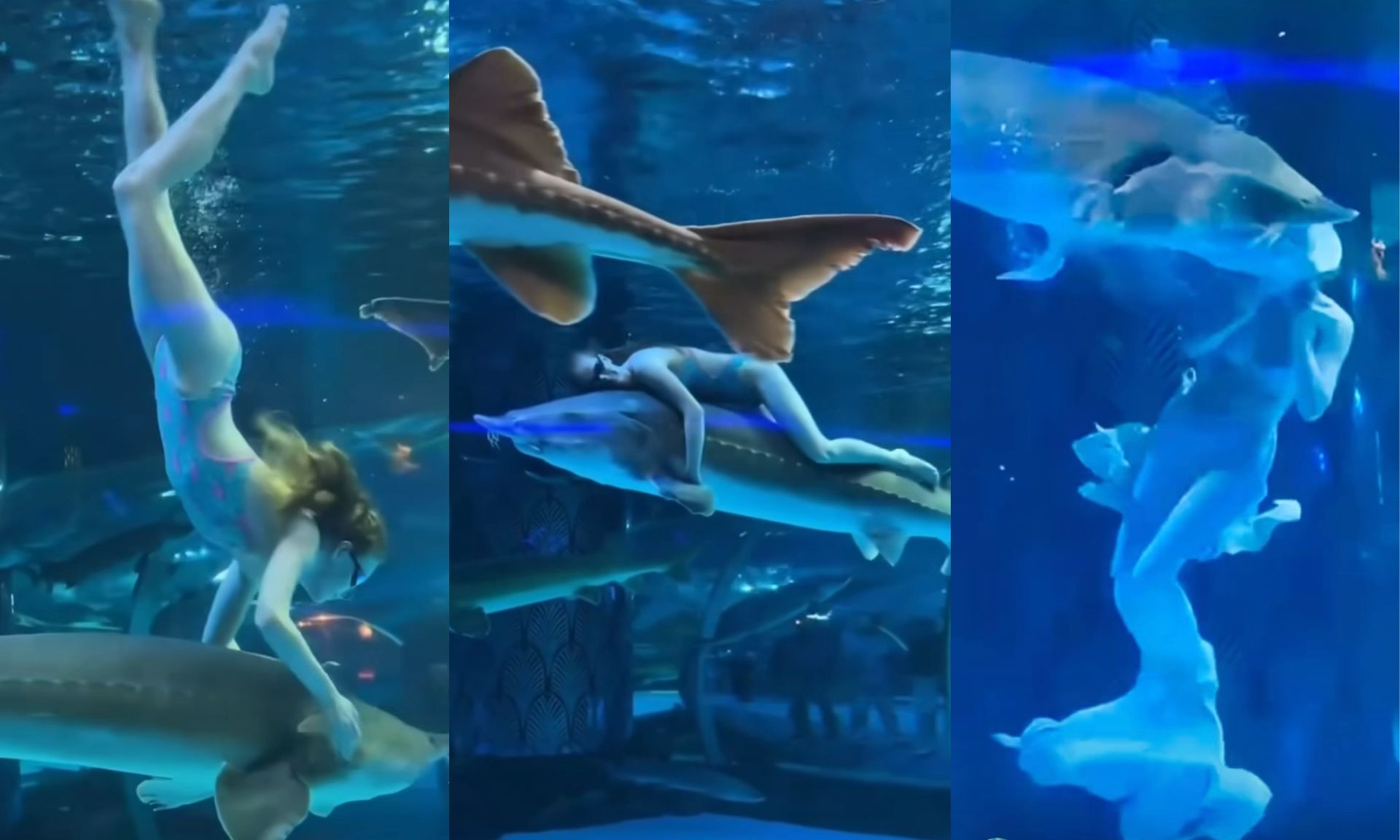
Is Mermaiding Safe? Lessons from a Shocking Mermaid Performance Accident
A recent aquarium accident has sent shockwaves through the mermaid world, highlighting the urgent need for better safety standards. As mermaiding grows, so must our commitment to performer well-being. Dive into what went wrong, why proper training and teamwork are essential, and how we can create a safer industry. This is a must-read for anyone passionate about underwater performance. 🌊✨
Corinna Schwozer
2/12/20255 min read
Mermaids have long captured the imagination of people worldwide. But for professional mermaids who bring this dream to life, performing isn’t just about magic and flowy tails—it’s about skill, safety, and collaboration.
Recently, the mermaid community was shaken by an incident where a performer was attacked by a sturgeon in an aquarium show. It was a sobering reminder that while the industry has grown, we still have a long way to go in terms of standardized safety protocols and best practices.
As the CEO of MerMapp, a platform built to connect and empower mermaids around the world, I strongly believe this is a moment where we must come together and push for better industry standards. Because the truth is, this accident could have been prevented—if we, as a community, had stronger systems in place.
So, let’s dive deep into what happened, why it happened, and what we need to do as an industry to ensure safety in professional mermaiding.
The Aquarium Incident: What Happened?
Performing in an aquarium isn’t just about swimming gracefully alongside marine life. It requires a delicate balance of teamwork, knowledge, and preparation.
Every safe aquarium performance relies on three key roles—the "Holy Trinity" of underwater shows:
1️⃣ The Mermaid Performer (The Artist)
Professional mermaids are trained athletes. A performer must be:
✔️ Highly skilled in breath-hold diving (apnea)
✔️ Comfortable working with animals in a confined space
✔️ Trained in emergency escape techniques
But here’s the thing—a performer can’t be responsible for safety alone. This is where the next two roles come in.
2️⃣ The Safety Diver (The Underwater Guardian)
A trained safety diver is always present in professional mermaid shows. Their role is to:
✔️ Monitor the mermaid’s well-being and provide air if needed
✔️ Intervene in case of distress or unexpected animal behavior
✔️ Assist in emergencies—like pulling a mermaid to the surface if necessary
Without a safety diver, an underwater performance is immediately riskier.
3️⃣ The Aquarist (The Animal Expert)
The aquarist is the bridge between the mermaid and the marine life. They:
✔️ Know the behavior of each species in the tank
✔️ Ensure the animals are well-fed before performances to avoid food aggression
✔️ Identify potential risks and advise on safe interactions
In the case of the sturgeon attack, one or more of these roles failed—either because there was a lack of communication, missing safety measures, or insufficient understanding of the animal’s behavior.
The @singaporemermaid, who is a highly professional and experienced mermaid has explained this very nicely in this video here.
Why Did This Happen? Understanding the “Holy Trinity” of Aquarium Performances
What This Means for the Mermaid Community at Large
This issue isn’t just about aquariums. It’s a symptom of a bigger problem:
Mermaiding is still a very young industry, and clear safety guidelines are not widely established. Unlike scuba diving or freediving, which have strict training protocols and certification standards, mermaiding has little regulation.
This lack of structure leads to inconsistent training, inexperienced performers taking on high-risk gigs, and a general lack of awareness around safety.
The reality is:
Many new performers don’t have proper freediving or emergency training.
Event organizers don’t always understand the risks of underwater performance.
Even experienced mermaids may underestimate the importance of formal safety planning for each gig.
If mermaiding is going to grow and be respected as a serious profession, we need to set a higher standard for ourselves.
In a now widely discussed accident, a professional mermaid was performing in an aquarium tank when she was suddenly attacked by a sturgeon, sucking in the mermaid performer's head. As these fish don't have teeth in their adult stages, the performer was only slightly injured - however, the scene was of course a horrific one and the trauma caused is not to be underestimated either.
For those unfamiliar, sturgeons are large, powerful fish. They can grow up to 18 feet long and weigh over 1,500 pounds. While they aren’t naturally aggressive toward humans, they can become defensive or mistake movement for food—especially in captive environments where their interactions with humans are controlled but not always predictable.
This accident, shocking as it was, raised a crucial question: How did this happen?
How We Can Do Better—Together
So, where do we go from here? How do we build a mermaid industry that is safer, stronger, and better connected?
Here’s what needs to happen:
1️⃣ We Need Standardized Safety Guidelines
Just like scuba divers have PADI and freedivers have AIDA, mermaids need a globally recognized training and safety certification.
Imagine if every mermaid performer had to complete:
✅ Animal behavior and interaction training
✅ Aquarium performance risk assessments
✅ Emergency response training for underwater incidents
This would prevent accidents before they happen.
2️⃣ Collaboration Between Performers, Aquariums & Safety Professionals
The "Holy Trinity" model should be a mandatory industry standard, not an optional luxury.
Aquariums need to:
🔹 Ensure safety divers are always present
🔹 Require aquarists to be involved in performance planning
🔹 Regularly assess risks with performers
Mermaids need to:
🔹 Refuse unsafe working conditions
🔹 Demand proper safety measures in contracts
🔹 Speak up if safety concerns are ignored
2️⃣ Foster a Culture of Knowledge-Sharing 🌊
🔹 More experienced mers should mentor newer ones, passing down knowledge and best practices.
Aquariums, dive centers, and mermaid schools should collaborate to ensure safety is always a priority.
MerMapp’s Role in Building a Safer Mermaid Community
At MerMapp, we believe that knowledge should be accessible and easy to find for every mermaid—whether you’re a beginner or a pro performer.
How MerMapp Can Help:
✅ Connect with other mers in real-time – We already have a Discord community where mermaids from all over the world can connect, share experiences, and ask for advice.
✅ Professional Networking – For our premium members, we offer an exclusive channel for professional mermaids to collaborate, network, and share industry insights. Whether you’re a performer, coach, or event organizer, this is where you can exchange knowledge and opportunities.
✅ Mermaid Performance Checklists & Templates – We’re currently working on industry-standard templates and checklists for mermaid performances, covering safety protocols, best practices, and risk assessments. Want to be the first to access them? Join the waiting list!
✅ Training & Safety Resources – We’re building an easy-access section in MerMapp for best practices, training recommendations, and performance safety templates.
✅ Find the right mentors & locations – Whether you’re looking for trained professionals to guide you or safe, fin-friendly pools and ocean spots, MerMapp makes it easy to find and connect.
The more we centralize knowledge, the easier it will be for new and experienced mers to access the right resources and perform safely.
While this discussion is about improving the industry, we also want to send our deepest support to the mermaids who have experienced accidents like this. No one should have to endure harm in the water, and while we wouldn’t wish these incidents on anyone, they serve as powerful wake-up calls for the entire community.
That said, safety isn’t just about luck—it’s about responsibility. Some accidents happen because of poor training, lack of awareness, or not respecting the wildlife we share the water with. While it’s easy to place blame, we must remember that we’re all human—we all make mistakes. What truly matters is that we acknowledge those mistakes, learn from them, and work together to create safer industry standards.
If you’ve had a similar experience or want to share your learnings, MerMapp offers a safe space to connect, support each other, and grow together. Whether it’s through our Discord community or in-app connections, you’re not alone. Let’s take these lessons forward and ensure a safer, more professional mermaid industry—together. 💙🌊
Sending Our Support—And Learning From the Past
Mermaiding is not just about looking pretty underwater. It’s a real profession, a real sport, and a real industry—and it’s time we treat it that way.
We owe it to ourselves, our fellow performers, and the next generation of mers to push for better safety, more education, and stronger industry collaboration.
Let’s learn from this accident and make sure it never happens again.
Final Thoughts: The Future of the Mermaid Industry
🌊 If you’re a professional mermaid, let’s talk! Join our Discord community to share experiences and discuss industry improvements.
📩 Sign up for our waiting list to get early access to mermaid performance checklists & safety templates.
💙 Let’s build a safer, stronger mermaid industry—together!
👉 What safety practices do you think should be required for professional mermaids? Drop your thoughts in the comments!
What’s Next?


APPearl LTD
Nikiforou Vretakou, 5, Flat/Office 101
8035, Paphos, Cyprus
registration number: HE 433676
VAT number: 10433676W
Contact Us
+(357)96520653
contact@mermapp.com
©️ 2021-2025
Crafted with 💙
by APPearl LTD
